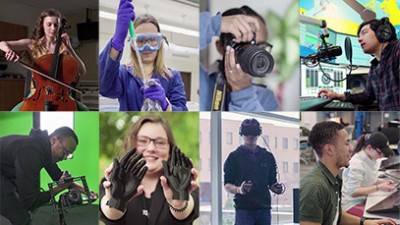Dumped Coffee on Your Keyboard? Never Fear, Ultrasonic Cleaning is Here
Researchers at RIT develop environmentally safe cleaning technique
Did you eat lunch at your desk one too many times and get your keyboard keys so sticky you’re ready to throw it in the trash?
Before you furtively stash it with the mounting pile of damaged keyboards in the supply room, consider this: It can be saved.
The clean technologies group at the National Center for Remanufacturing and Resource Recovery (NCR3) at Rochester Institute of Technology has developed an ultrasonic method of cleaning gunk out of computer keyboards, making them as good as new.
The keyboard-cleaning discovery came about through projects with the New York State Energy Research and Development Authority (NYSERDA). NCR3 also works with the Environmental Protection Agency on sustainable product design, developing tools to look at end-of-life strategies that should be incorporated into the initial design process, says Nabil Nasr, director of NCR3 and head of the Center for Integrated Manufacturing Studies which houses NCR3.
NCR3 also works with NYSERDA developing ultrasonic and other environmentally conscious industrial cleaning methods for a variety of parts and products, from automotive parts to ink jet cartridges to fuel cells.
Keyboard cleaning process
The keyboards are disassembled, though the keys are left on, and all the non-electronic parts are submerged in a cleaning tank full of a mild, alkaline aqueous solution. The keyboards are agitated by ultrasonic energy in the same process as jewelry cleaning.
The agitation, caused by ultrasonic sound waves, creates small bubbles in the liquid. When the bubbles hit the keyboard parts, they explode. This mini-explosion scours the dirt off the parts without harming them.
Economic benefits
Cost of cleaning a keyboard: about $1 per unit, including disassembly and reassembly time.
Cost of a replacement keyboard: ranges from about $10 for a basic model to $50 or more for a fancy, ergonomically enhanced model.
As people upgrade their computers less frequently, it makes economical and environmental sense to extend a keyboard’s life and avoid buying new replacements when they go bad, says Monica Becker, NCR3 researcher.
Environmental benefits
Though keyboards are not the worst environmental offender, (environmentalists are more concerned about the lead in CRTs and CPUs that contain multitudes of toxic materials in their circuit boards, switches and other components) they do contain:
usually one relatively small circuit board: circuit boards contain toxic heavy metals such as lead and cadmium; often they contain brominated flame retardants
cables which typically contains brominated flame retardants
a plastic casing which also contain brominated flame retardants
Brominated flame retardants are environmentally persistent (i.e. they don’t break down in the environment) and are suspected carcinogens.
By refurbishing keyboards, you avoid all the environmental and human health impacts associated with mining, processing, and manufacturing and disposing of these environmental hazards as well as the energy required along the way, Becker says.
So what does manage to wiggle its way into the inner workings of your everyday office keyboard? The NCR3 team found this in theirs: crumbs, soda, some stickers and a small insect.
The National Center for Remanufacturing and Resource Recovery (NCR3) is the nation’s leading center for applied research and development in remanufacturing, helping remanufacturing and resource recovery industries improve productivity, reliability and processes without harming the environment. With its advanced proven technologies and hands-on experience, NCR3 is uniquely capable of developing the innovative and concrete solutions needed to take remanufacturing and resource recovery industries to the cutting edge. It is part of the Center for Integrated Manufacturing Studies (CIMS) at Rochester Institute of Technology, a world-class organization with a mission to increase the competitiveness of United States manufacturers through applied technology and training. Established in 1992, the Center for Integrated Manufacturing Studies (CIMS) provides technology and workforce development solutions that strengthen industrial clients’ ability to compete in the global marketplace.








